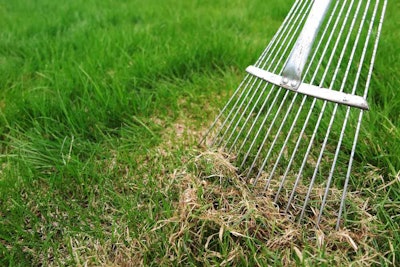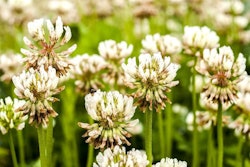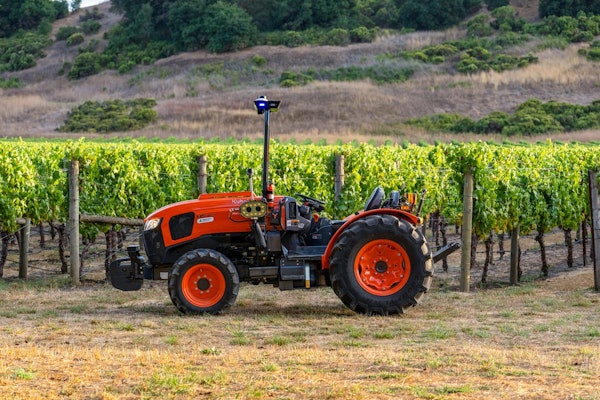
What is thatch?
Simply put, thatch is a layer of living and dead organic matter that is between the zone of vegetation and the soil surface. When a lawn begins to have a spongy feel to it, this can be a sign an excess of thatch is occurring.
Thatch is composed of stem nodes, crowns, fibers of vascular tissues and roots and about 25 percent of thatch is made from a compound named lignin. Lignin is resistant to decay by microorganisms and can cause thatch to build up faster than it can be broken down.
Is it good or bad?
A common question some homeowners want an answer to is whether thatch is good or bad. But a better question is how much thatch is healthy? Like a majority of things in life, thatch is best in moderation.
A thin layer of thatch (less than ½ inch) can be beneficial for a yard, helping insulate it from extreme temperatures and foot traffic. It can also reduce weed germination by keeping weed seeds from reaching the soil and helping retain soil moisture. Penn State’s Center for Turfgrass Science says that about ½ inch can be helpful on sports turf, as it boosts resiliency and softens the impact, but any lawn with more than an inch of thatch will start to experience problems.
Excessive thatch can cause numerous issues. The thick layer can harbor pests and diseases and trap roots in the layer, subjecting them to drought and temperature extremes. Too much thatch can limit the ability of oxygen, water, insecticides and pre-emergent herbicides to reach their intended target.
Mower scalping can also occur when there are thick layers of thatch. As the mower wheels sink into the thatch, the height of the cut is also lowered. The crowns of grass growing in thatch also tend to be elevated above the soil, making it more likely to be scalped.
Causes of thatch accumulation
There are a number of factors that can lead to thatch buildup, which is when organic matter is produced faster than microorganisms can decompose it.
Depending on the species and variety of turfgrass in question, certain species produce more stem tissue than others, causing them to create more thatch faster than other species. Cool-season grasses such as Kentucky bluegrass, creeping red fescue and creeping bentgrass all form thatch at an accelerated rate and even certain cultivars of these grasses are worse with accumulation than others.
Meanwhile, perennial ryegrass and tall fescue tend to not produce significant thatch buildup. Yet even if you do have a grass that typically does not have problems with thatch accumulation, aggressive fertilization with nitrogen can stimulate too much production in the stems and leaves, resulting in an overabundance of thatch.
Another element that allows thatch to build up is reduced microbe activity, which can occur in acidic soils (5.5 pH or lower) as this inhibits microorganisms from being able to decompose thatch. Compacted, clay or sandy soils can also lack the needed population sizes of microorganisms to keep thatch under control.
Pesticides that reduce microorganism or earthworm activity can also decrease thatch breakdown. Overgrown grass, excessive watering and lack of aeration are all other contributors that can lead to unhealthy amounts of thatch.
Preventing thatch
The best control for thatch is to have a good management program in place and most of the thatch’s catalysts can be prevented by just following good cultural practices that you should be conducting anyway.
Taking soil tests regularly can alert you to any changes in the pH that would cause microbial activity to drop, while core aeration alleviates soil compaction and boosts microorganisms’ activity as well.
Applying fertilizer in controlled amounts that do not cause rapid growth and only using pesticides when they are needed can also improve the rate of thatch breakdown.
There is a misconception that grass clippings contribute to thatch. Yet there is little evidence to support this belief, as it often decomposes quickly.
“However, if a thick thatch layer already exists, returning clippings can cause thatch increases,” wrote Peter Landschoot, a professor of turfgrass science at Penn State. “This may be due to the inability of decomposing microbes to persist in the upper thatch layer where clippings accumulate.”
Also, don’t overlook considering starting fresh with a more suitable grass type. Aggressive grass cultivars might be able to grow quickly, but they’ll end up causing more issues from the thatch accumulation. Mixing perennial ryegrass with the more aggressive types can help reduce the amount of thatch formed.
Removing thatch
If your client has thatch already over one inch, preventative practices are not going to be able to control the problem.
Thatch can be removed with rakes, a vertical mower, or a dethatching mower, depending on the quantity. In some regions, people burn their yards in an attempt to remove thatch, but this is very risky and not very effective.
Depending on how severe the thatch accumulation is, you can end up removing a fair amount of the turf as well, if the root system has begun growing in the thatch layer.
Dethatching is a stressful process for the turf, so it should be conducted when the grass is actively growing and the soil is moderately moist. Early spring or early fall is the best time for cool-season grasses, while late spring through early summer after a couple of mowings for warm-season grasses.
This service can be bundled along with other renovation practices such as aeration, fertilization, and overseeding you may offer.









